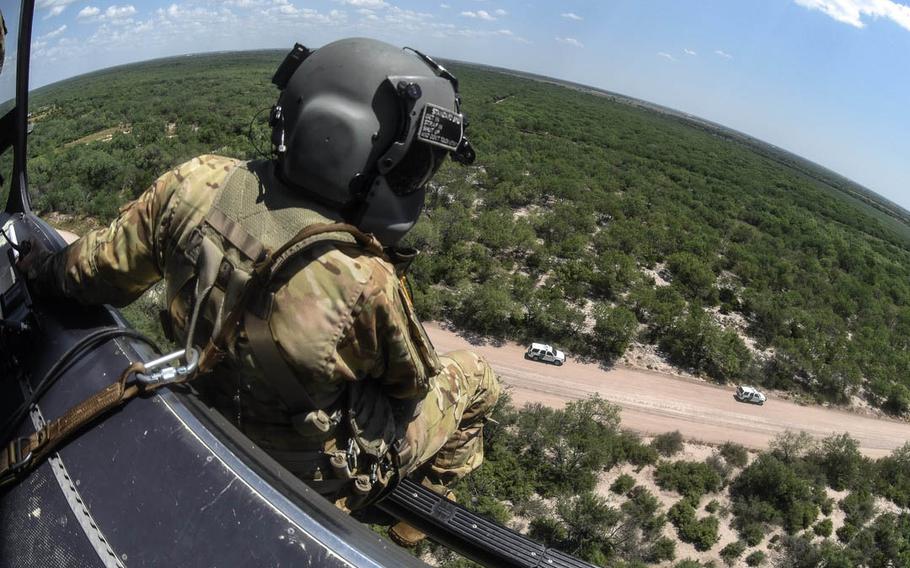
National Guard troops provide airborne support to the U.S. Department of Homeland Security near the southwest border with Mexico in McAllen, Texas, along the Rio Grande Valley in July 2018. (Roberto Di Giovine/U.S. Army photo)
WASHINGTON — Defense Secretary Jim Mattis on Friday approved a request from the Department of Homeland Security to send a second deployment of U.S. military troops to the U.S.-Mexico border after President Donald Trump pledged to send servicemembers to halt illegal immigration.
The latest allotment of troops will include logistics, engineering, medical and aviation specialists, the Pentagon said Friday, more than a day after U.S. officials confirmed DHS had requested the deployment at Trump’s behest. Troops will bring temporary barriers, barricades and fencing to set up along the border. The troops will also bring fixed- and rotary-wing aircraft, temporary structures and protective gear to outfit U.S. Customs and Border Protection personnel, according to the Pentagon statement.
Defense officials said Thursday that the deployment would not include combat forces, such as infantrymen. Homeland Security Secretary Kirstjen Nielsen said in an interview with Fox News on Thursday that the requested troops were to “bolster” the Border Patrol’s efforts.
“We do not have any intention right now to shoot at people, but they will be apprehended, however,” she said.
The new deployment comes as Trump has raised concerns for more than a week about a loosely organized group of several thousand Central American migrants, commonly referred to as a caravan, traveling toward the United States. The migrants, who have said they are seeking refugee status, are walking through southern Mexico by foot and remain more than 1,000 miles from the U.S. border, according to The Associated Press.
Nonetheless, Trump has continually warned the group poses a threat to the United States ahead of the Nov. 6 midterm elections.
“It’s a big caravan,” the president said Friday during a meeting with young black conservatives at the White House. “I called up the military. We’re not letting them in. They ought to go back now because we’re not.”
The Pentagon statement Friday did not indicate how many troops would be sent to the border or if the servicemembers would be active-duty troops, National Guard members or reservists. On Thursday, U.S. officials, who spoke on condition of anonymity, said the deployment would include active-duty Army soldiers.
The statement also did not clarify when the troops would begin deploying, though officials indicated some forces could be shipped to the southern border as early as next week. Pentagon spokesmen on Friday declined to comment on the issue beyond the statement.
The newly deploying troops would join the roughly 2,100 National Guard members already operating along the U.S.-Mexico border, where they are tasked predominately with aiding Border Patrol agents. Those troops, ordered by Trump to the border in April, have been barred from interacting with migrants. Most of them are also barred from carrying weapons, however officials said all troops retain the right to defend themselves.
The Pentagon statement issued Friday indicates the new deployment would not fall under that National Guard mission. It said U.S. Northern Command would have control of the deploying forces “in support of Custom and Border Protection.”
“This assistance is in addition to the previously authorized support to CBP’s Operation Guardian Support mission,” the statement said.
The 1878 Posse Comitatus Act bars the use of American military personnel for civilian law enforcement efforts on U.S. soil, outside military installations.
Nonetheless, presidents in recent decades have regularly deployed Guard troops to the border to aid Border Patrol operations. Active-duty troops have been commonly used within the U.S. mainland to aid in natural disaster relief, but they’ve rarely been ordered to support border operations, Pentagon officials said.
The National Guard troops now at the border have conducted some surveillance operations, but they have worked largely in administrative or vehicle maintenance roles behind the scenes, freeing Border Patrol agents to conduct law enforcement operations, according to the Pentagon.
The original Trump order in April authorized up to 4,000 National Guard troops to serve the border mission. They are operating under the control of state governors from Texas, Arizona, New Mexico and California.
dickstein.corey@stripes.com Twitter: @CDicksteinDC